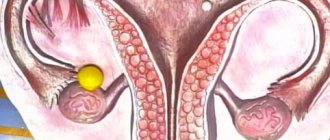- Share on Facebook
- Share on VKontakte
- Share on Odnoklassniki
Frozen pregnancy is a problem that is practically not talked about in our society. How to move on and where to find the strength to start planning a pregnancy again? Women who, after failure, did not despair, but experienced the happiness of motherhood, shared their stories.
Photo source: mirmam.pro
Often doctors cannot name one specific reason for a missed abortion. Often this situation occurs at the intersection of many factors - autoimmune, infectious, obstetric. No one is safe from the death of a child in the womb.
Reference: A non-developing (frozen) pregnancy is a pregnancy that, for medical reasons, spontaneously terminated prematurely. It can end in a miscarriage, in which the remnants of the fertilized egg come out of the uterus on their own. If a miscarriage does not occur, the doctor will prescribe curettage, surgical cleansing of the uterus from the remnants of the fertilized egg.
“community of agni” - brotherhood of students of the hierarchy of light
In order for children, having lost moral guidelines in life, to stop believing in God and end their lives with suicide, out of despair into which the lawless and immoral government drove them. yes I don’t know no In order for our children to stop praying and lose grace from a young age, which is good for managers, since they are easy to manage, because their attention is completely focused on receiving pleasure alone, which is detrimental to the individual yes I don’t know no We against such a government that, turning a blind eye to permissible pornography, has done everything to destroy chastity and morality in our children yes I don’t know no We are against the accessible openness of pornography and similar abominations of search engines Yandex, Google and the like, and we demand that these disgusting systems be banned in the territory of our Russian State yes I don’t know no Important! 1.
“I lay on the bed and howled like a wolf into this emptiness”
The cleaning was done the next day. Olga admits that living with a dead child inside is one of the most difficult experiences in life. But after cleaning it is no easier.
“There was just a bottomless black emptiness inside, I lay on the bed and howled like a wolf into this emptiness. All I remember is someone’s warm female hands that rocked me, someone whispered something and gave me strong black tea.
Photo source: pixabay.com
Only a few hours later Olga realized that she was lying in the ward. There were those who had already lost a child, and those who hoped to save him. This fact outraged the heroine most of all.
— Amazing insensitivity and tactlessness on the part of the Belarusian state. 10 years have passed and I am still outraged.
Causes of intrauterine death during childbirth
If the fetus dies, the woman wonders who is to blame, what was the reason, and how to avoid repeating this scenario in the future.
As a rule, the culprits of fetal death during pregnancy are diseases of the mother. In the forefront are infectious diseases such as pneumonia and influenza. Next - pathologies of the body, congenital and acquired diseases, such as heart disease, kidney disease, diabetes, anemia. In third place on the list of possible causes are inflammatory and other diseases of the female reproductive system.
If the fetus dies late in pregnancy (after 28 weeks), then this may be due to pathologies of the placenta or late toxicosis, problems with the umbilical cord (nodes), oligohydramnios, or a conflict between the Rh factor of the mother and child.
Possible causes also include poisoning of a pregnant woman (heavy metals, drugs, alcohol, nicotine, phosphorus), the use of medications, excess or lack of vitamins in the body of a pregnant woman, injuries and stress.
The above causes can also lead to death during childbirth, but there is another type of cause associated with mechanical damage: spinal injuries and traumatic brain injuries.
For an accurate diagnosis, ultrasound, FCG and ECG of the fetus are sufficient.
Birth of a stillborn fetus (stillbirth)
A great danger to the fetus is posed by changes in the body of the expectant mother, associated with the possibility of a very dangerous pregnancy complication called EPH-preeclampsia (EPH - preeclampsia: Eodema, Proteinuria, Hypertensia) and is manifested by high blood pressure, proteinuria and edema.
Info
Diseases and infections such as tuberculosis, syphilis, hepatitis and emphysema, infections (rubella, measles, influenza, hepatitis and others), as well as other infectious diseases with high fever, carry the same danger.
All types of drugs taken during pregnancy, as well as alcohol and nicotine, have a huge impact on the fetus.
Under the influence of these drugs, a narrowing of blood vessels in the placenta and uterus may occur, which does not allow the fetus to receive oxygen and nutrients in the required volume, and a lack of nutrients can cause stillbirth.
School of esoteric psychology "Jiva"
If the disintegration was caused by an intrauterine infection, then there is also a threat to the mother, as this may complicate the complete and proper healing of the post-operative wound. In this case, the treatment procedure is very difficult, therefore, to avoid septic complications after expulsion of the dead fetus, antibiotic prophylaxis is often administered.
Amniocentesis is also recommended, the use of prostaglandins to soften the cervix so that the canal is most receptive. They are mainly used in gel form and are inserted into the cervical canal.
Immune and autoimmune factors
Recently, the immunological factor has become increasingly common. Since the fertilized egg consists half of the father’s genetic information, the expectant mother’s body can perceive it as a foreign body. This provokes the production of antibodies that interfere with the development of the fetus. In other words, the embryo is rejected by the woman’s immune system.
Adhesive feature of the authors. Request for compensation proposed by parents. An examination that did not demonstrate the inadequacy of the medical procedure to which it was presented to pregnant women. Illegality of unverified behavior. There is no cause-and-effect relationship between the alleged error and the result. A commitment that has a means rather than an end.
Judgment of inadmissibility, on the grounds that the pregnancy was intrauterine, and there was no diagnostic error during ultrasound examinations. The author appeals to the defense for the refusal of the request for an oral test. It is necessary to hear the report of the expert and the doctors who visited him during the death of the fetus. He intends to prove that there was an error in the diagnosis. If the oral test is rejected, the applicant must file an appeal. Inertia causes estoppel of matter.
A large number of antibodies to phospholipids found in the blood plasma causes the appearance of autoimmune disorders. The first place among them belongs to antiphospholipid syndrome. Almost 5% of cases of fetal freezing occur due to the presence of this pathology. With subsequent pregnancies, this figure increases to 42%. The main reason for the appearance of this syndrome is heredity. The pathology provokes the formation of blood clots and significantly complicates the situation during pregnancy.
Although estoppel was not taken into account, it is the prerogative of the oral test to prove the factual issue. The technical test that would have been necessary was carried out. The expert's report is expressed by determining that all lying ultrasound images are consistent with a current intrauterine pregnancy. The findings of the examinations carried out in the appeal laboratory are consistent with the expert’s report; the pregnancy was current. Diagnostic errors are not recognized.
It is impossible to hold the author responsible for the pain. The cause of action is based on a failure to provide public health which, when properly verified, imposes a duty to compensate the accused as a result. There was no error in the service provided to the author because the equipment defect and the causal relationship between the death of the fetus and the defendant's conduct were not proven in the records. Therefore, given that there was no evidence to establish that the death of the fetus occurred due to the failure to provide a medical hospital service, a causal link between defendant's conduct and the injurious event is not thus established, and the absence of the prerequisites of a duty to pay damages is not established.
Intrauterine fetal death. causes, symptoms and diagnosis
The most accurate way to determine a frozen pregnancy, both in the early and late stages, is an ultrasound, during which a specialist will check:
- Inconsistency between the size of the uterus and the duration of pregnancy;
- Absence of heartbeat and breathing movements;
- Incorrect position, deformation and contour around the fetal body in late stages, indicating tissue decomposition;
- Lack of visualization and growth of the embryo in early pregnancy. It is very rare, but it also happens that the fertilized egg continues to grow for some time, but the embryo in it does not form or has stopped developing.
We suggest you familiarize yourself with: How to register real estate in fact, a household building.
This is also the reason for the problems that sometimes arise with determining a frozen pregnancy based on the results of an analysis for hCG - the second method of diagnosing pathology. It happens that an ultrasound indicates that the development of pregnancy has stopped, but the level of hCG in the blood continues to rise, since it is produced by the membrane of the fertilized egg, or it itself remains at a high level for several days after the death of the fetus. As you can see, a test for a frozen pregnancy can show a positive result, because and its action is based on the detection of hCG in the urine.
Although, as a rule, the level of hCG during a frozen pregnancy decreases sharply or is equal to zero. Read more about hCG levels during pregnancy→
As a result of a frozen pregnancy, two scenarios are possible:
- Spontaneous miscarriage in the early stages, when the uterus rejects the dead embryo and removes it from the body;
- Medical intervention. If it is not carried out on time, then in the later stages the decomposing fetus will poison the mother’s body with decay products, which will lead to serious consequences for her health.
So, if a frozen pregnancy is diagnosed, then its termination is currently possible in several ways.
1. Medication. This is a way to terminate a frozen pregnancy in the early stages. A woman is prescribed drugs that provoke uterine contractions, and, as a result, a miscarriage.
2. Curettage, or curettage (cleaning) during a frozen pregnancy. A fairly popular, although not the most desirable, procedure, since during it tissues are injured and the likelihood of complications is high.
The operation is performed under general anesthesia and consists of mechanical cleaning of the uterine cavity, removal of its upper mucous layer, with a special instrument that is inserted into the cervical canal, having previously provided access there by installing dilators.
After the operation, bleeding or inflammation may develop, so the woman should remain in the hospital for several more days, where her well-being will be monitored.
3. Vacuum aspiration. The operation, performed under anesthesia or local anesthesia, involves the woman having her uterine cavity cleaned using vacuum suction. It looks like this: the tip of a vacuum apparatus is inserted into the cervical canal (without dilation).
After the procedure, the woman should be under the supervision of a doctor for about two hours. Of course, this method of terminating a frozen pregnancy is more gentle than curettage. In addition, the woman will not have to stay in the hospital for a long time.
4. Childbirth. In the later stages, termination of a frozen pregnancy is much more difficult, mainly from a psychological point of view. The fact is that a non-developing pregnancy is a contraindication for cesarean section (the contents of the uterus can be infected), so there is only one way out - artificially inducing labor. That is, a woman cannot simply disconnect from the process, for example, under anesthesia, she must give birth to a dead fetus herself as an emergency.
It is also worth noting that in the early stages, doctors sometimes do not make any attempts to terminate a frozen pregnancy, waiting until the uterus itself rejects the fetus.
After a frozen pregnancy, an examination is prescribed to determine the cause of the pathology. If one can be established, it is recommended to undergo a course of appropriate treatment.
We invite you to read: Registration of a commercial concession agreement
As a rule, tests after a frozen pregnancy include:
- blood test for hormone levels;
- smear and examination of the vaginal microflora for the presence of sexually transmitted infections;
- histology after a frozen pregnancy - study of the uterine epithelium. For analysis, a thin section of the upper layer of the uterus or tube is taken, or material obtained during curettage is used.
As for the restoration of the uterus after surgery, a course of antibiotics and hemostatic agents is usually prescribed, as well as abstinence from subsequent pregnancy for a certain time (depending on related factors).
In case of detected genetic abnormalities of the fetus, after a missed pregnancy, a consultation with a geneticist will be required to determine the compatibility of the partners.
How long it is undesirable for a woman to become pregnant is determined by doctors in each specific case, at least it will be six months. Until then, a woman needs to use contraception and not worry about the fact that she will no longer be able to conceive a child. These fears are completely unfounded.
A frozen pregnancy is, as a rule, a special case that in no way indicates a disorder in the woman’s reproductive system.
However, remember, in order not to experience this blow again, the woman must undergo a thorough examination, adhere to a healthy lifestyle and competently approach planning the next pregnancy. In addition, it is very important that not only the expectant mother takes care of her health, but also the future father supports her in this.
Of course, surviving a frozen pregnancy is very difficult, and in the later stages the depth of this tragedy simply cannot be expressed in words. But instead of falling into despair, a woman needs to switch all her attention to taking care of her health, and soon she will know the joy of motherhood.
A feeling of heaviness in the abdomen, weakness, cessation of breast enlargement and engorgement, cessation of uterine growth in a pregnant woman, as well as cessation of motor activity and fetal heartbeat indicate intrauterine death.
If a woman experiences the above symptoms, she urgently needs to consult a gynecologist at an antenatal clinic or a good private clinic, where this diagnosis will be refuted or confirmed.
In addition, the causes of intrauterine death include infections in the womb, oxygen starvation (fetal hypoxia), deformities that disrupt the vital functions of the body. Symptoms of fetal death A feeling of heaviness in the abdomen, weakness, cessation of breast enlargement and engorgement, cessation of growth of the uterus in a pregnant woman, as well as the cessation of motor activity and heartbeat of the fetus indicates its intrauterine death.
For an accurate diagnosis, ultrasound, FCG and ECG of the fetus are sufficient. What happens next If intrauterine death of the fetus occurs, the time for which its body remains in the uterus can be considered from a couple of days to several years.
Risk group
No one is immune from fetal death, but there are risk factors that must be taken into account:
- If a woman has already had unsuccessful pregnancies and her first child is stillborn.
- The woman suffers from hypertension and preeclampsia.
- The woman has a history of chronic diseases: diabetes, pyelonephritis, thrombophilia, endocrine disorders.
- Serious complications of pregnancy.
- Bad habits: smoking, alcoholism, drug addiction.
- Multiple pregnancy. The greater the number of children, the greater the risk of stillbirth. Why is the maternity hospital so sensitive to multiple pregnancies? Precisely because various risks increase.
- The pregnant woman is obese.
- The pregnancy resulted from IVF.
- Too young or old age.
Why a child dies in the womb from the esoteric side
Starting from the earliest stages of pregnancy, it is very important to communicate with your baby, sing him songs and tell him stories, since the baby’s speech is formed even before his birth.
magazine "World of Happy Families"
Histological studies of an embryo that has died are carried out to find out the reason why the death occurred. A man and a woman are forced to face a cytogenetic examination. Tests will show whether there were chromosomal abnormalities, infectious pathologies or other factors. When an infection is detected, both partners are treated.
We suggest you read: Possible options for discharging a minor child
You cannot plan your next pregnancy immediately after the frozen embryo has been removed. The body will be rehabilitated for some more time (six months to a year) so that there are no problems with physical and psychological health.
It is necessary to conduct strict monitoring of pregnant women with the possibility of hospitalization, monitor the main indicators of their body, such as blood pressure, pulse, temperature, the values of which can be recognized as an indicator of the onset of infection, if there are deviations from the norm, as well as the study of fibrinogen, which allows to identify early detection of blood clotting disorders.
If a dead fetus remains in the uterus for a long time, it can cause many complications for the mother, threatening her life and it is not recommended to wait for the spontaneous expulsion of the fetus. The expulsion of the fetus from the uterus must be done no later than 2 weeks after its death. Pregnancy should be terminated immediately if there are indicators of the onset of infection, such as fever, elevated white blood cell count.
During fetal movements during pregnancy or during labor as the baby passes through the birth canal, the placenta sometimes sheds prematurely, posing a serious threat to the life of the fetus. Another danger posed by the umbilical cord is related to its location - the threat arises if it is located in front of the front of the fetus.
This complication is extremely rare and usually occurs in pregnancies where abnormal fetal position coexists, such as transverse position, pelvic position, or polyhydramnios, or when the pregnancy is multiple. The death of an unborn child may also be associated with the presence of various severe fetal defects.
Among the most common defects are defects of the heart, kidneys, nervous system and others. Intrauterine fetal death is suspected in the absence or slowing of growth, as well as cessation of fetal movements.
"Doctors don't like to talk about it"
Stillbirth is not an uncommon occurrence. WHO gives statistics: up to 3.2 million annually around the world. For Russia, statistics are not obvious, since in our country infant mortality is considered to be all cases of death of a child under the age of one year. However, there is data for 2010, when more than 8,000 episodes of intrauterine death of a child at 20 weeks of pregnancy were recorded.
When I looked for a doctor willing to comment on this topic, I came across refusals or silence. “Why do you need to delve into medical details? Women don’t need to know how the birth of a stillborn child goes,” an experienced obstetrician-gynecologist, an employee of one of the private clinics in Moscow, told me.
“Nobody likes to talk about this topic. And no one likes to give birth like that either. This is a closed topic,” is the anonymous admission of the deputy chief physician of one of the capital’s large maternity hospitals.
Quite in a whisper and with the request “just not for publication!” the doctors said: it’s all about statistics. No one wants to see infant mortality rates increase in the maternity hospital - they spoil the reputation and can cost the hospital a reduction in funding, and the chief doctor his job.
“In our society, there remains an attitude towards a pregnant woman as a kind of vessel that must give out its contents. And if the “product” turns out to be of poor quality, they look at her as if she has the plague. There is an order for healthy, pink, successful children. Everything else should be forgotten,” says Veronika Nazarova, a doctor at the Center for Traditional Obstetrics and Family Medicine.
Impact of infectious diseases
Acute and chronic forms of infectious diseases are also a great threat to the life of the fetus. The most common cases of fetal death are in the presence of herpes, mycoplasmosis, chlamydia, etc. They may appear earlier. But during this period there is a significant decrease in the woman’s immunity, and because of this, any illness during pregnancy manifests itself more intensely.
In the first trimester, cytomegalovirus poses a great threat, which very often causes pregnancy to fail. But in later stages it provokes the appearance of various developmental defects.
But, unfortunately, it is not always possible to determine why antenatal fetal death occurred. The reasons for it often remain unknown.
Survey
General examination of the woman - taking vital signs to rule out sepsis, shock due to bleeding and symptoms of preeclampsia. A urine test for proteinuria is important.
Examination of the abdomen may reveal nothing suspicious or may reveal symptoms of placental abruption or local signs of injury in the mother indicating damage to the uterus. After excluding the most important diagnosis - placenta previa - a vaginal examination reveals signs of bleeding or inflammatory discharge. In this case, it is necessary to take smears for bacteriological examination.
In the UK, after diagnosis of intrauterine fetal death, the majority of women choose active treatment tactics to complete the pregnancy. Among those who choose conservative tactics, spontaneous labor begins within 2 weeks from the moment of fetal death in 80% of women.
It is necessary to discuss the issue of post-mortem examination of the fetus and placenta to determine the cause of intrauterine death before delivery. Parental consent to complete fetal autopsy depends on location and cultural traditions. Some choose limited external x-rays of the fetus in combination with an examination of the placenta.
Pregnancy is arbitrarily divided into trimesters, although it is a collection of closely related phenomena. Common causes of fetal loss in the first trimester are genetic abnormalities, in the second trimester - infections and in the third trimester - problems with the placenta and umbilical cord. However, this does not always happen this way. Fetal death in the second or third trimester can be caused by one or many reasons; its onset can be acute, subacute or chronic.










